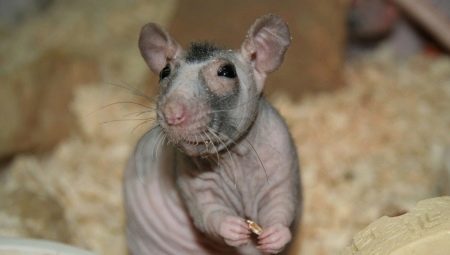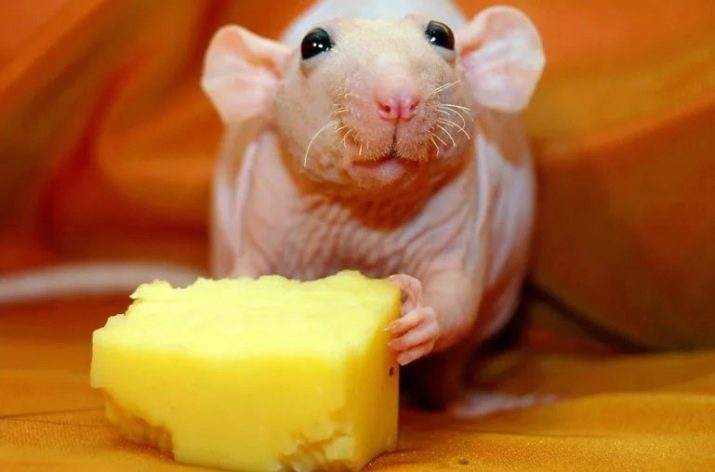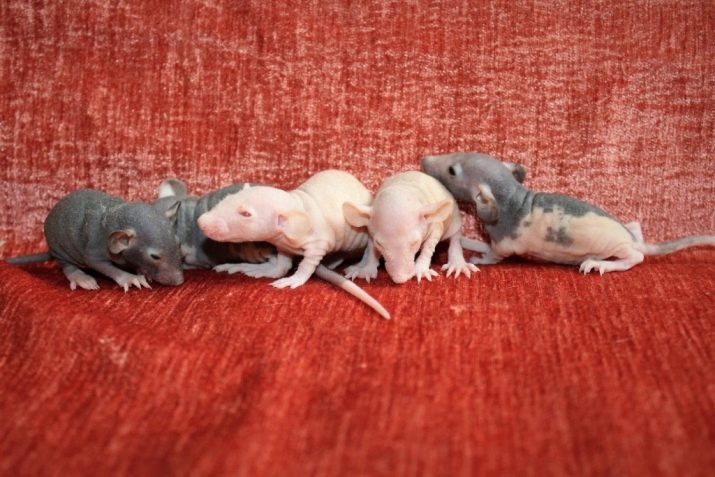Bald rats: breed characteristics and care tips

Exotic pets have become very popular lately. Rodents, which are very often bred as decorative pets, have not spared this trend either. The bald rat is actively raised by many breeders today, so fans of the sphinxes can be found all over the world.

Description
The Hairless rodent breed, or simply the Sphynx, was artificially obtained by an American scientist. Initially, such animals were needed for various experiments and studies, but over time, outlandish bald rats became interested in humans as decorative pets. This served as the impetus for the release of individuals outside the scientific offices and laboratories.
There are three species of sphinxes.
- Standard. Rodents with long whiskers and small patches of hair on the skull, limbs and sides. Some breeders, due to their external characteristics, call individuals porcupines.
- Rex. Rats with curled vibrissae and rather sparse wavy hair on the head, in the groin, and on the paws.
- Double Rex. Individuals of this variety have sparse hair on their bodies.



Since the hairless gene is recessive, it is not passed on to every animal. This led to the birth of rodents with partial body hair. Such distinctive features in appearance suggest the classification of animals into several subspecies. Today the following can be distinguished:
- hairless;
- naked;
- fluffy;
- balding;
- naked;
- cropped.






Immediately after birth, you can observe how the rodents' hair grows and covers their body, but then falls out, as a result of which rare hairs remain on the rats. Therefore, based on the hairline, it will be possible to assign an animal to one or another subspecies no earlier than one and a half months after its birth.
The size of the sphinxes can vary from 15-25 centimeters, while the mass of adults is 400-700 grams. In light of the lack of undercoat and wool itself, the animals have a rather graceful body shape.

As for the skin color of bald decorative rats, then ideally, it should be pink, free from defects and blotches. In this case, the presence of folds is allowed, to the touch the body of the animal will resemble velvet. As a rule, boys have thicker skin than girls. Now, through selection, animals have been bred whose skin color will not be pink, but smoky, black, cream and even chocolate.
Rodents have whiskers (vibrissae) that are located near the eyes. The antennae are slightly curled, in the light of which they will be visually shorter in length than in ordinary decorative rats.
In some individuals, vibrissae may be absent, however, such a feature will indicate a deviation from the established standards of appearance inherent in sphinxes.

Some difference in the shape and fit of the ears can be noted in bald individuals. They will generally be set rather low and will also be larger than the ears of common rodents. There are animals with a characteristic shape of the auricles, like those of dumbo rats. The eyes of the sphinx are pronounced, located on both sides of the skull. The color of the pupils can be black, husky, red and even pink. Among the animals of this breed, it is also possible to meet animals with different eye colors.
Sphynxes stand out for their docile disposition, however, this does not affect their activity in any way, so the rodents willingly play, and also very quickly get used to their owners. A similar feature in the character of bald rats is due to the fact that, due to their lack of hair, animals can and should be allowed to spend more time in direct contact with a person - on their hands, in their bosom, on the shoulder. The heat emanating from the wearer's body has a pacifying effect on them, in addition, it warms.

At home, with regular contact with a person, rats are able to very sensitively recognize the mood of the owner by the intonation of his voice. Therefore, the breeder should control his timbre when communicating with the pet, so as not to frighten him. Bald rats are able to remember and respond to their nicknames. The animals are clean, therefore, with free walking around the house, the breeders do not have problems with cleaning the waste products of the sphinx in the places of its movement.
The lifespan of bald ornamental rodents is 1.5-2 years, however, if you properly care for the rodent and provide it with a balanced diet, it will be able to live longer with humans.

Advantages and disadvantages
The decorative breed of hairless rats stands out for its strengths and weaknesses. The advantages of animals include the following points:
- due to the lack of wool, such pets can be started even if a person has allergic reactions to animal fur;
- rats almost do not exude the unpleasant odor characteristic of small rodents;
- unlike hamsters, sphinxes are very contacts, therefore they quite willingly go into the hands of a person;
- animals stand out for their decorative appeal due to their unusual appearance;
- bald rats have high intellectual abilities, therefore they recognize the mood of a person well, and are also able to remember their nickname.

Among the disadvantages of such rodents, it is worth highlighting the following nuances:
- sphinxes can suffer from depression alone, so you should definitely communicate with animals;
- rodents are not long-livers, so one individual with a person will not live long.

Care and maintenance
For such exotic pets, the main point regarding the content is the temperature regime in the room.Experts recommend placing cages with rodents in rooms where the air will be heated in the range from +22 to +30 C. Sometimes you can allow an increase in thermometer readings up to +35 C.
In winter, sphinxes are usually kept near heating devices or radiators. As for the summer months, bald rats should be protected from the sun's rays, because due to the lack of hair, they can get burns from ultraviolet radiation.
The optimal indicator of air humidity will be 75–80%, an increased humidity indicator can cause the development of various ailments in a rodent.

Dwelling
Pets live in spacious cages with metal rods, inside them a container for food, a drinking bowl, and also cuts of paper or napkins should be placed as material to create a nest in which the sphinx will sleep. Suitable dimensions for the house will be 70x70 centimeters, in such conditions the rodent will have enough space to move. It is best to choose houses with several tiers, with stairs and partitions.
In addition to the material for the nest, it is worth installing a house inside the cage in which the rodent will rest and sleep, and also take cover if necessary. Animals rather willingly sleep in hammocks.


It is recommended to clean the house twice a week., the rodent will also need a tray. Common cat litter products can be used as filler.
For games and physical activity, rats do not need a wheel; a walking ball will be the best option for such a pastime.

Nutrition
As for the diet of a bald rodent, such pets can be fed with specialized feed mixtures, additionally treated with vegetables and fruits. Once every seven days, the sphinx should be given boiled fish and meat, vegetables should also be boiled beforehand. Animals should not eat salty, smoked and spicy foods; one should refuse the temptation to treat the rodent with sweets from the common table.
Cheese will be the favorite treat for a decorative rat, however, you can pamper an animal with it no more than once a week.

Hygiene
Sphynxes quickly grow claws on the front and hind limbs, so the owner will need cut them once a month with sharp scissors... Neglect of such rules will in the future be fraught with wounds on the animal's body, in addition, the rat can injure its owner with its claws in the process of communication.
It is recommended to bathe your pet in warm water once every 2-3 months, however, it is impossible to use additional care products, there will be enough water for hygiene procedures, since the rat washes and takes care of itself in between.

For such small rodents, attention from the breeder is very important - if the owner knows in advance that the rat will mostly be alone at home, he should purchase several sphinxes at once. It is best to choose animals of the same sex and from the same litter. But this does not negate the need for daily contact and communication with the rat.
As noted earlier, bald rats do not stand out for their vitality, most often the rodent suffers from a variety of skin ailments. Some abrasions and wounds on the body of the animal can turn into purulent ulcers.

Another common ailment among sphinxes is oncology, such a predisposition is due to gene mutations, as well as a lack of hair. Such diseases in rats are not yet subject to treatment.
Rats breed well at home, females are in heat every 5-7 days. That is why heterosexual animals living in the same cage will regularly bring offspring to the breeder. It is not recommended to mate sick animals, as there is a possibility that they will pass on their illness to their offspring.
It is forbidden to take newborn rat pups in your arms, since sphinxes, like most rodents, if foreign odors are detected in the offspring, can eat all the cubs. Bald rat cubs can be placed in a separate house within a month after birth.

Professional advice
Sphynx breeders strongly recommend buying such decorative pets exclusively in specialized pet stores, since animals that are offered on natural markets are very often kept with violations of conditions, which is fraught with future health problems. In addition, you can get important advice from specialists regarding the care of an ornamental rodent.
Sphynx breeders recommend paying attention to the fact that animals regularly renew their teeth. To assist rats in a painless and correct course of these processes, a piece of wood should be specially placed in the house.
Rats need mineral supplements, for this purpose it is recommended for pets to purchase vitamins or put chalk in the cage.



For inexperienced breeders who have purchased two pets of different sexes, however, they do not plan to breed animals, many veterinary clinics offer services for neutering and neutering animals. This will allow you to avoid possible problems with numerous offspring of bald rats in your home.
In the next video, see the opinion of the little breeder about her pet - a bald rat.








